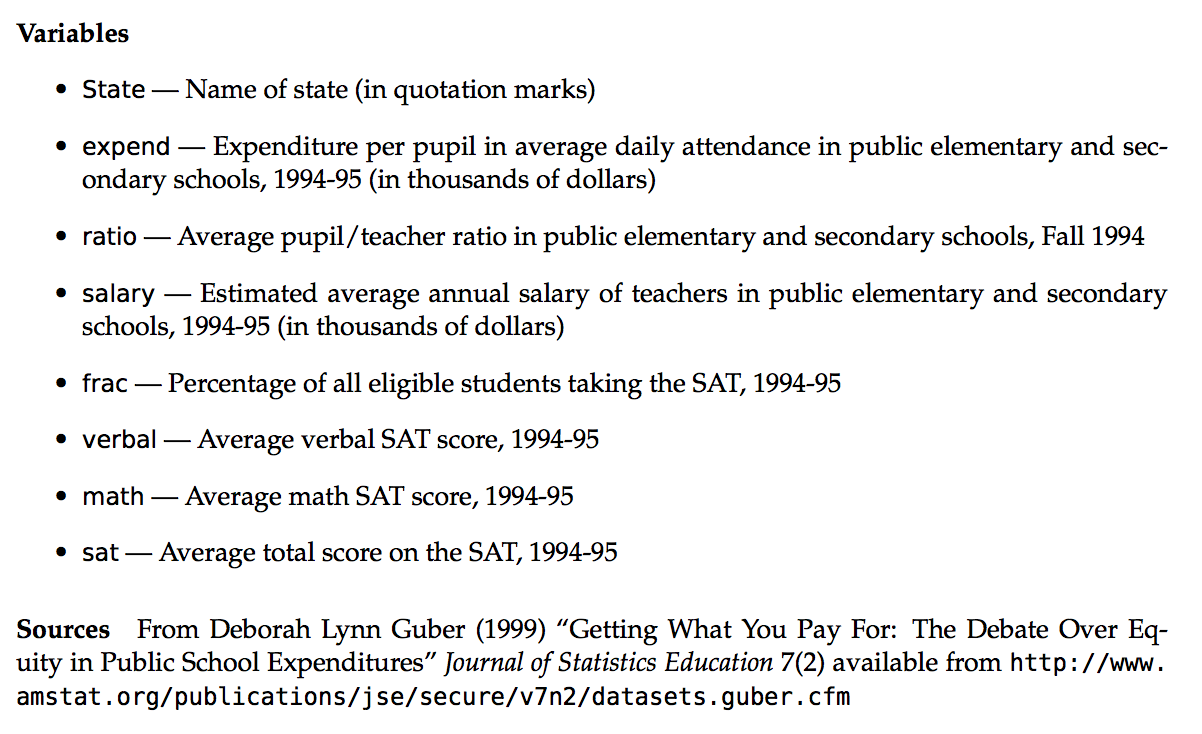Multivariate Visualizations + Idea Lab
Switch it Up
Sit with someone new today!
- Introduce yourself
- Share best or worst part of the week so far
Announcements
Every week in MSCS
- Thursday 11:15am Coffee Break in Smail Gallery
This week in class
- TT2 due tomorrow
Today we’ll practice discussing “insights” we gain from our visualizations. Then, we create some visuals by hand!
Learning Goals
- Understand how we can use additional aesthetics such as color and size to incorporate a third (or more variables) to a bivariate plot
- Develop comfort with interpreting heat maps and star plots, which allow you to look for patterns in variation in many variables.
More Aesthetic Attributes
To go beyond 2 variables, we need to add aesthetics for each new variable!
Data: Exploring SAT Scores
Though far from a perfect assessment of academic preparedness, SAT scores have historically been used as one measurement of a state’s education system.
| State | expend | ratio | salary | frac | verbal | math | sat | fracCat |
|---|---|---|---|---|---|---|---|---|
| Alabama | 4.405 | 17.2 | 31.144 | 8 | 491 | 538 | 1029 | (0,15] |
| Alaska | 8.963 | 17.6 | 47.951 | 47 | 445 | 489 | 934 | (45,100] |
| Arizona | 4.778 | 19.3 | 32.175 | 27 | 448 | 496 | 944 | (15,45] |
| Arkansas | 4.459 | 17.1 | 28.934 | 6 | 482 | 523 | 1005 | (0,15] |
| California | 4.992 | 24.0 | 41.078 | 45 | 417 | 485 | 902 | (15,45] |
| Colorado | 5.443 | 18.4 | 34.571 | 29 | 462 | 518 | 980 | (15,45] |
Data: Codebook

Univariate Density
Variability in average SAT scores from state to state:
Bivariate Scatterplot
What degree do per pupil spending (expend) and teacher salary explain this variability?
ggplot(education, aes(y = sat, x = salary)) +
geom_point() +
geom_smooth(se = FALSE, method = "lm") + theme_classic() +
theme(text = element_text(size=20))
ggplot(education, aes(y = sat, x = expend)) +
geom_point() +
geom_smooth(se = FALSE, method = "lm") + theme_classic() +
theme(text = element_text(size=20))

Is there anything that surprises you in the above plots? What are the relationship trends? Discuss as a group.
Example: Three Variables
Let’s make a single scatterplot visualization that demonstrates the relationship between sat, salary, and expend.
Thoughts:
1. We could use the color or size aesthetics to incorporate the expenditure data.
2. Include some model smooths with geom_smooth() to help highlight the trends.
Example: Three Variables
Another option!
Categorize your 3rd Quantitative Variable!
Example: Fraction who take SAT
The fracCat variable in the education data categorizes the fraction of the state’s students that take the SAT into low (below 15%), medium (15-45%), and high (at least 45%).
- Make a univariate visualization of the
fracCatvariable to better understand how many states fall into each category.
Example: Fraction who take SAT
- Make a bivariate visualization that demonstrates the relationship between
fracCatandsat. What story does your graphic tell?
Example: Fraction who take SAT
- Make a trivariate visualization that demonstrates the relationship between
fracCat,sat, andexpend. IncorporatefracCatas the color of each point, and use a single call togeom_smoothto add three trendlines (one for eachfracCat). What story does your graphic tell?
Example: Fraction who take SAT
- Putting all of this together, explain this example of Simpson’s Paradox. That is, why does it appear that SAT scores decrease as spending increases even though the opposite is true?
Discuss!
Other Multivariate Visualization Techniques
After class, I want you to look through the heat maps and star plots. I want you to reflect on the insight you gain from the different plots.
Handmade Visualizations
Let’s go to Google Doc for the instructions.
Your task: Create a visualizations based on the data provided with any materials available.
Handmade Visualizations - Data
| Name | Area (acres) | Max depth (feet) |
Watershed area (acres) |
Chain of lakes | Longitude | Latitude | City |
| Bde Maka Ska | 401 | 87 | 2992 | Yes | -93.311883 | 44.941966 | Minneapolis |
| Lake Harriet | 335 | 85 | 1139 | Yes | -93.304514 | 44.921725 | Minneapolis |
| Lake Nokomis | 204 | 33 | 869 | No | -93.241582 | 44.908678 | Minneapolis |
| Cedar Lake | 170 | 51 | 1956 | Yes | -93.321751 | 44.959361 | Minneapolis |
| Lake of the Isles | 109 | 31 | 735 | Yes | -93.306507 | 44.955482 | Minneapolis |
| Lake Hiawatha | 54 | 33 | 1734 | No | -93.236044 | 44.920906 | Minneapolis |
| Lake Como | 71 | 15 | 1783 | No | -93.140153 | 44.979637 | St Paul |
| Lake Phalen | 198 | 91 | 14720 | No | -93.053102 | 44.986744 | St Paul |







